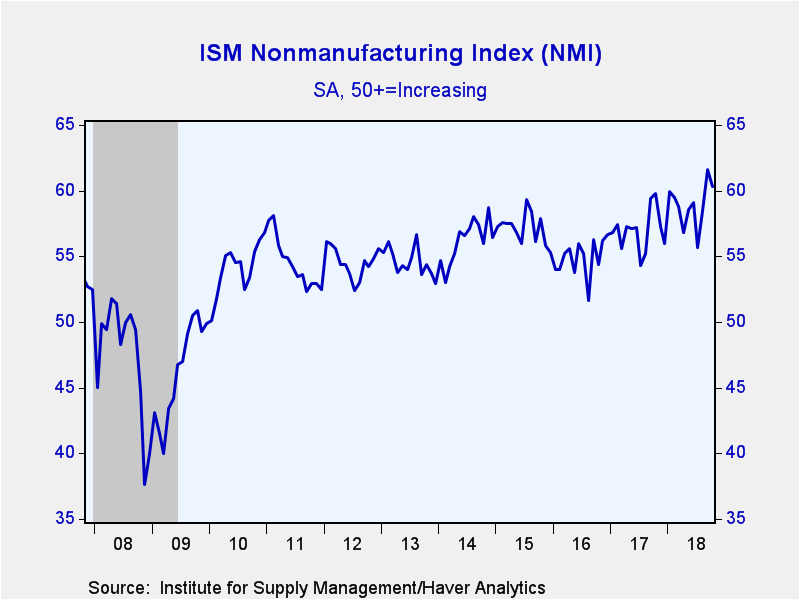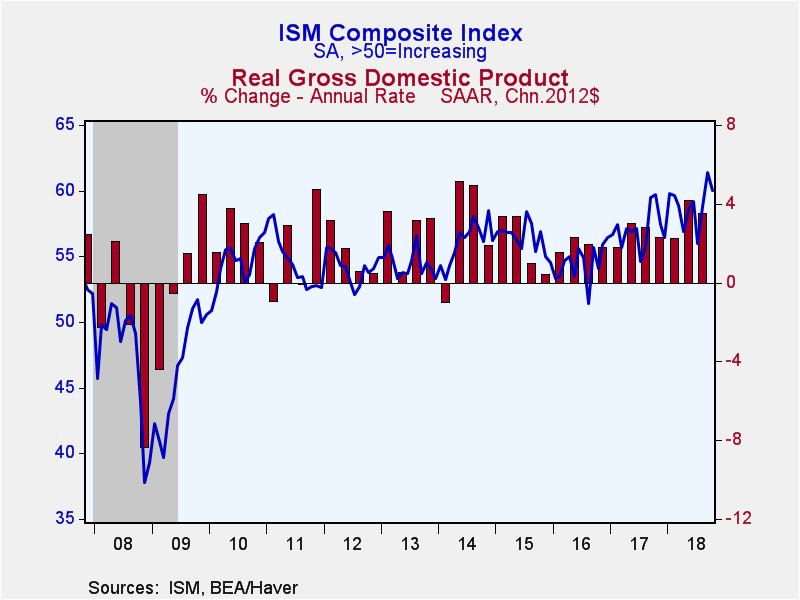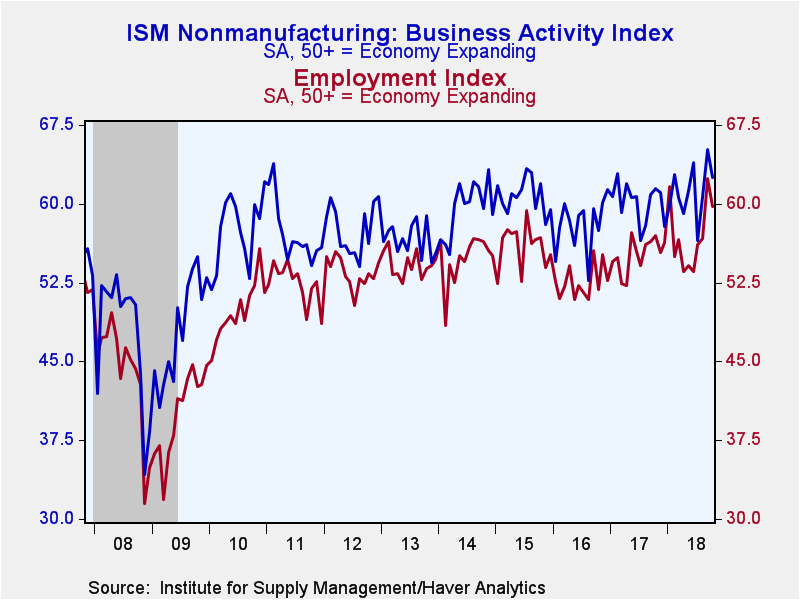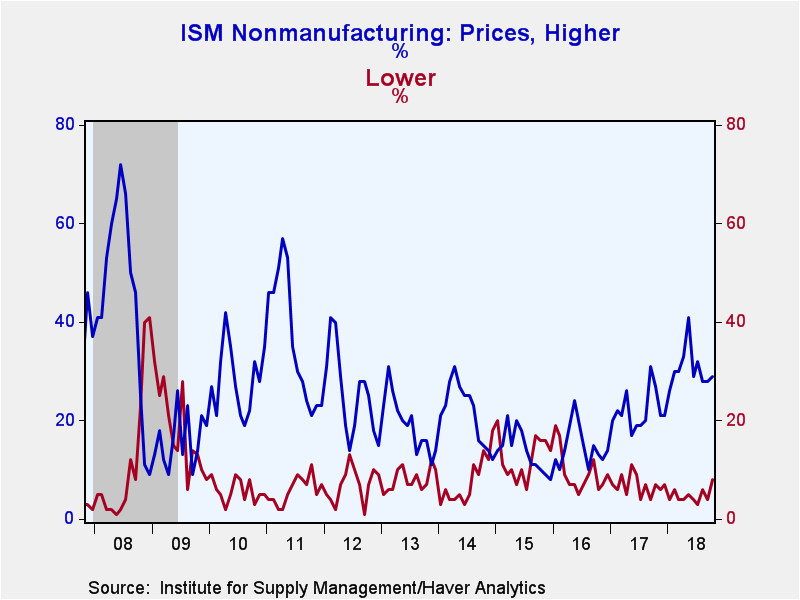 Global| Nov 05 2018
Global| Nov 05 2018U.S. ISM Nonmanufacturing Index Eases
by:Tom Moeller
|in:Economy in Brief
Summary
The Composite Index of Nonmanufacturing Sector Activity from the Institute for Supply Management (ISM) backpedaled to 60.3 during October following a jump to 61.6 in September. The Action Economics Forecast Survey expected a greater [...]
The Composite Index of Nonmanufacturing Sector Activity from the Institute for Supply Management (ISM) backpedaled to 60.3 during October following a jump to 61.6 in September. The Action Economics Forecast Survey expected a greater decline to 59.3. The ISM measures are diffusion indexes where readings above 50 indicate expansion.
Haver Analytics constructs a Composite Index using the nonmanufacturing ISM index and the ISM manufacturing measure, which was released last week. This composite declined to 60.0 in October and gave back a piece of its rise to 61.4 in September. During the past 15 years, there has been a 71% correlation between this index and the quarter-on-quarter change in real GDP.
The decline in the overall index reflected a drop in the business activity series which fell to 62.5 after rising to a strong 65.2 during September. The new orders index eased to 61.5 from a three-month high of 61.6. To the upside, the supplier delivery series indicated a slight slowing of delivery speeds with an increase to 57.5, the highest level since May.
The employment index fell to 59.7 last month after rising to a record 62.4 in September. A stable 31% of respondents reported a rise in payrolls while a higher 13% reported a decline.
Price inflation was indicated to have softened as the prices index eased to 61.7, the lowest level in four months. A slightly higher 29% of respondents reported a rise in prices while a stronger eight percent reported a decline, the most since June of last year.
Among the other detail indexes, which are not seasonally adjusted, the export order series held steady m/m and has been fairly stable all year. The import index declined sharply to its lowest reading since February, while the order backlog index also fell sharply after rising strongly in September.
The ISM figures are available in Haver's USECON database, with additional detail in the SURVEYS database. The expectations figure from Action Economics is in the AS1REPNA database.
| ISM Nonmanufacturing Survey (SA) | Oct | Sep | Aug | Oct'17 | 2017 | 2016 | 2015 |
|---|---|---|---|---|---|---|---|
| Composite Diffusion Index | 60.3 | 61.6 | 58.5 | 59.8 | 56.9 | 54.9 | 57.1 |
| Business Activity | 62.5 | 65.2 | 60.7 | 61.5 | 60.1 | 58.0 | 60.8 |
| New Orders | 61.5 | 61.6 | 60.4 | 62.6 | 59.3 | 57.5 | 59.2 |
| Employment | 59.7 | 62.4 | 56.7 | 57.0 | 55.2 | 52.6 | 56.0 |
| Supplier Deliveries (NSA) | 57.5 | 57.0 | 56.0 | 58.0 | 53.2 | 51.5 | 52.5 |
| Prices Index | 61.7 | 64.2 | 62.8 | 61.5 | 57.7 | 52.6 | 50.6 |
Tom Moeller
AuthorMore in Author Profile »Prior to joining Haver Analytics in 2000, Mr. Moeller worked as the Economist at Chancellor Capital Management from 1985 to 1999. There, he developed comprehensive economic forecasts and interpreted economic data for equity and fixed income portfolio managers. Also at Chancellor, Mr. Moeller worked as an equity analyst and was responsible for researching and rating companies in the economically sensitive automobile and housing industries for investment in Chancellor’s equity portfolio. Prior to joining Chancellor, Mr. Moeller was an Economist at Citibank from 1979 to 1984. He also analyzed pricing behavior in the metals industry for the Council on Wage and Price Stability in Washington, D.C. In 1999, Mr. Moeller received the award for most accurate forecast from the Forecasters' Club of New York. From 1990 to 1992 he was President of the New York Association for Business Economists. Mr. Moeller earned an M.B.A. in Finance from Fordham University, where he graduated in 1987. He holds a Bachelor of Arts in Economics from George Washington University.










